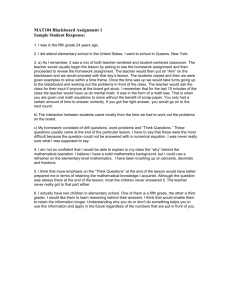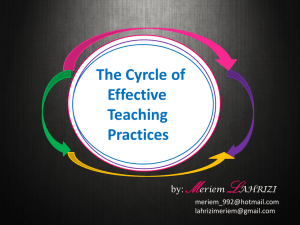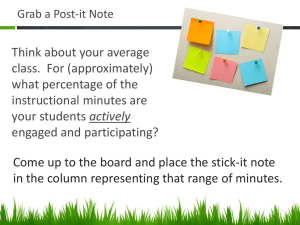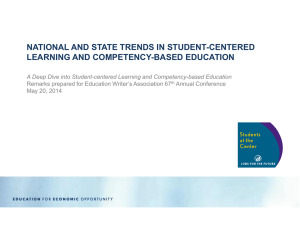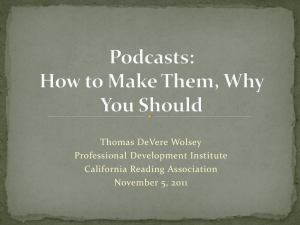Digitizing the Traditional Classroom for Distance
advertisement
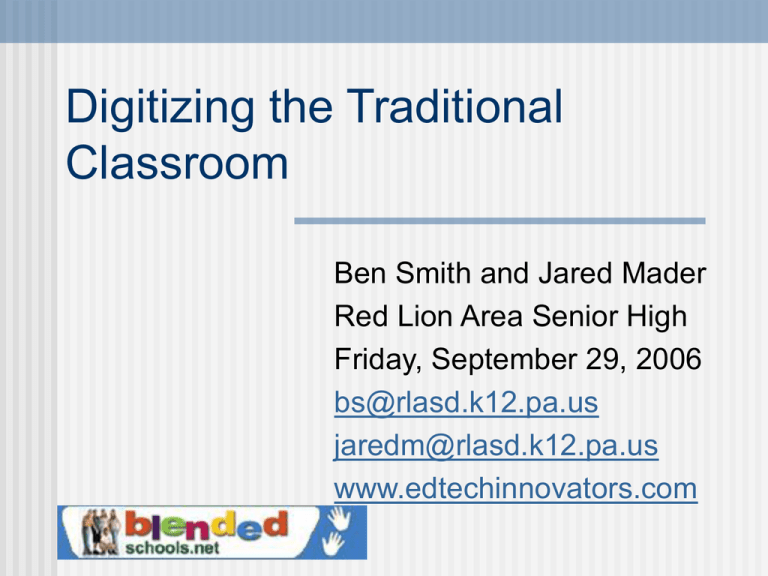
Digitizing the Traditional Classroom Ben Smith and Jared Mader Red Lion Area Senior High Friday, September 29, 2006 bs@rlasd.k12.pa.us jaredm@rlasd.k12.pa.us www.edtechinnovators.com About Us Ben Smith Physics Teacher K-12 Science Coordinator Technology Resource Teacher ISTE Consultant Keystone Technology Integrator Jared Mader Chemistry Teacher Technology Staff Development Trainer Core Skills Technology Training Leader Discovery Educator Network Keystone Technology Integrator Authentic Assessment A Constructivist View Students demonstrating problem-solving, reasoning, and engaging in activelearning. Essential Components Student-centered Product is a part of the process Higher-order thinking skills are employed Technology as the Medium Technology is simply the tool used to facilitate student-centered learning Technology makes it easier to accomplish Focus must remain on the curriculum and the student needs Curriculum must drive the need for technology, not the reverse Taxonomy for the Instructional Use of Computers Experiencing Informing Reinforcing Integrating Utilizing Adopted from Thomas and Boysen, Iowa State University The Traditional Science Class Demonstrations Inquiry-based questioning Hands-on activities Laboratory Investigations Class discussions Group activities/dynamics One-on-one interaction The Technology Enriched Science Class Still contains the essential elements of an effective traditional science class. Enhanced by: Probeware (Vernier/Pasco) Graphing Calculators (LabPro Interface) Software (Office, Inspiration, VideoPoint, iMovie, Interactive Physics) Teacher websites Virtual Side — Blackboard, Tapped In Podcasting, Weblogs Interactive simulations (applets, Shockwave) Wimba Elements Merging Technology to the Traditional Class Strengths Student-centered engagement Enables students of differing learning styles and personalities Increases instructional time Limitations Student Access Teacher/Student Time Usability Focus can drift from the curriculum to the technology Modes of Online Learning Online Students still schedule the online course during a normal period, yet they report to a computer lab or complete outside of school. Hybrid Students enroll in a traditional classroom that integrates the use of Blackboard as a supplement or enrichment to learning Review and Revision of Online Courses Constructed heavily around reading Limited student interaction/interactivity Be careful about too many distracting graphics Repetitive types of activities (although consistency in structure is necessary to allow students to become comfortable with the environment) Lacking essential elements of the technology rich classroom e.g. student-centered activities, forums, virtual classroom activities, group activities to promote collaborative exercises Constructing an Online Science Class Consistency in Design Format Content Delivery • Podcasting • Powerpoints and boardnotes Equipment on a budget Make use of household items Appropriate and effective discussions Discussion Boards • Establish clear discussion guidelines to your students Group Exercises • Require students to collaborate and create group projects using the online group discussion tools Virtual Classroom • Provide opportunity to establish a classroom-like environment Constructing an Online Science Class Variety of rich activities Concept mapping (Cmap and Inspiration) • http://cmap.ihmc.us/ Webquests/Scavenger Hunts • The Webquest Portal: http://webquest.org/ • e.g. Chemical Unknowns Interactive Laboratories • e.g. Biology Labs, Nye-Labs, Textbook Based Labs WISE Activities Online applets to promote interactivity Demonstrations and laboratory exercises • e.g. Gas Laws Demonstration Utilize online homework problem databases Many interface directly with Blackboard • e.g. ChemSkill Builder What Students Can Do Virtual Field Trips Assessment Higher level taxonomy Science writing Report on experience using Wimba tools Safe Assignment Submission Whiteboard solutions for small classes Virtual Classroom Making it Happen in Your District Staff Development Training Lessons are driven by the curriculum not the technology Lessons make greater use of the higher ends of the taxonomy. Notes Notes
